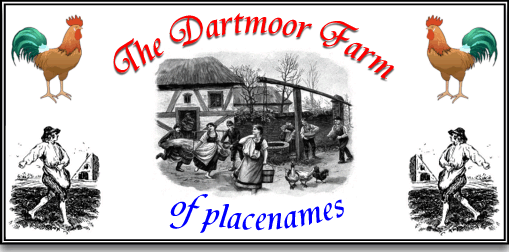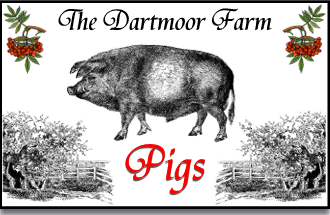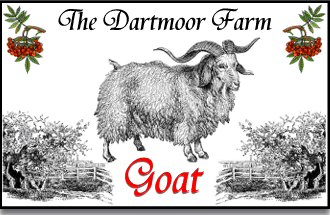
Another interesting exercise with the place-names of Dartmoor, many of these you will find are no longer marked on the OS map and have become lost somewhere in the past. So here we go…’Old Dart Mo-or had a farm, ee i ee i o, and on this farm there were some…’

Flock O’ Sheep, The – SX628 907
The Flock O’ Sheep is a cluster of granite rocks near the Small Brook, Crossing, p.211.
Sheep Fold, The – SX 64458 80908
A large ruined building on the slopes of Stannon tor once used to house sheep, the building burnt down sometime between 1820-30. Sometimes known as the Scotch Sheepfold. Alternatively, this was the building built as a starch factory. Crossing, 1990, p.477. Brown, 1973, p.4.
Sheep Measure, The – SX 65270 75596
A small enclosure near Loughtor (Laughter tor) used to count sheep. It was said that the farmer knew the number of sheep that it took to fill the enclosure therefore every time it was filled that number of sheep were in it. Also known as Loughtor Pound. Crossing, 1990, p.461.
Sheep Path, The – SX 5305 8510 (S – E)
An old track also known as The Quarryman’s Path which runs from Peter Tavy and Merrivale and was used by the men of Peter Tavy to get to work at Merrivale Quarry. In places the track is kerbed and in others it is a causeway, the purpose being that the men could find their way in the frequent dense fogs that occur in that part of the moor. Hemery, 1983, p.962.
Sheepstor – SX 55957 67658
A small village on southern Dartmoor that takes it name from the lofty tor that stands to the north-east.
Sheeps Tor – SX 56 68
A large tor on southern Dartmoor, home to the ‘Pixies Cave’.

Pigshill Droke – SX 6690 8580
On the north side of Middle tor there is a prehistoric field system, included in this is a parallel reave that runs southwards known as Pigshill Droke. The name ‘Pigswell’ is mentioned in a 13th century document and refers to a farm near Teigncombe and some adjacent lands, these presumably being the ‘Droke’, Hemery, p.760. The only definition of ‘droke’ that I have found is “a steep sided valley, sometimes wooded,” which would not apply in this case. After a lot of help from the members of the British Archaeology forum there are several possible meanings of the word ‘droke’; the Oxford English Dictionary suggests that it can mean a furrow, groove, ditch, small watercourse or a steep sided valley with an early context from 1772 as a part of a plough. There were several ideas that it is a Cornish term for a groove, a steep valley or channel or it derives from the Cornish word drog or drok which means bad or evil. Another reference is that of Heyward Sumner when talking in terms of The New Forest says that it is a name for an old sunken trackway or watercourse. Which is interesting as a reave normally appears as a low wall, most of the above descriptions refer to a groove or channel which implies something that has been cut into the ground as opposed to being built up from the ground?
Pig’s House, The – SX 64250 71903
This was possibly once an old tinner’s blowing House and is situated most appropriately in the valley known as Deep Swincombe (valley of the pigs). Later used by a herdsman to keep pigs, hence its name.
Piggie Rock – SX72955 82283
This is a large boulder situated to the west of Easdon tor which at one time is thought to have logged or rocked and was a logan stone, Hemery, p.725. There is said by some to be an alternative name for the rock and that is ‘Whooping Rock’. This name was thought to come from an old tradition where any children suffering from whooping cough were taken to the area where they could be near the sheep that grazed there. It was thought that being near them would cure the affliction, whether this came from the strong smell of ammonia which accompanies their urine I don’t know. There is also a mention of Whooping Rock in Carrington’s poem – ‘Dartmoor’ where in certain conditions it is supposed the wind makes a whooping sound when blowing around the rock, Crossing, p.265.

Cowflop Bottom – SX 614 814
Situated at near the head of Broada Marsh stream is an area where foxgloves used to grow, the old Dartmoor name for the foxglove is ‘cowflop’ hence Cowflop Bottom, Hemery, p.478.
Cow Bridge – SX 66145 86423
On the 1843 tithe map was marked ‘Cow Bridge’ today there is a slab of granite which is about 2.3 x .94m and sits between a leat and a brook at Batworthy Corner. The slab has been used as a marker for the Gidleigh bounds as is evident from the inscribed ‘G’.
Cowsic, The – SX 59367 80476 (head of river)
Possibly stretching things a bit but the Cowsic river is one of the many that flow into the Dart. According to Gover et al. the name Cowlsick Coume first appears in the Duchy of Cornwall documentary sources in 1612 and is too late for any suggestions as to its meaning, Gover et al, 1992, p.3.

Goose, The – SX 69410 64350
One of a series of boundstones which mark the limits of the lands belonging to Buckfast Abbey, Brewer, p.132.
Goosey Creep – SX 51932 81776
Goosey Creep is a small gully that was once worked by the tinners and is part of the old Wheal Jewell complex, Crossing, p.156.
Goose Eye, The – SX 7403 7577
A small spring that once was near to the above boundstone called The Grey Goose.
Gooseford – SX 676 918
There are two farms called Higher and West Gooseford and if taken logically would derive from the ‘Goose Ford’ and here is an excellent example of how place-names have to be treated with caution. The first documentary evidence was in the assize Rolls of 1249 and 1254 where the name appears as Goseford which refers to a personal name, Gover et al. p.451. Along with the farm names are Gooseford Cross (roads) and an old mine where Mispickel, an ore of arsenic, was extracted called the Gooseford Mine.
Grey Goose Nest, The – SX 74032 75773
This is a small boundstone that marks the bounds of the parish of Ashburton and Buckland in the Moor, Brewer, 2002 pp.112, 116. Also known as the Goose Nest.
Goose Pool, The – SX 68303 72820
A small area of half mire and half pool from which rises the little Row Brook, It is possible that the pool was a one-time water source for a nearby prehistoric settlement, Hemery, p.580.

Horse Brook, The – SX 71133 61448
A small brook which rises just on the eastern edge of Beara Common, the name appears on the Lay Subsidy Rolls of 1330 where it appears as Cristina de Horsbrok, Glover et al., p.292.
Horse Ford – SX 66295 71115
A small ford at which point the old Huccaby track crosses the O’ Brook, it was virtually washed away in a flood of 1965. Nearby is the old granite cross called Horse Ford Cross, Hemery, pp. 417, 570.
Horse Hole – SX 601 801
A small wet, boggy hollow beside the Summer Brook. It is here that the northern, western and eastern quarters of the Forest of Dartmoor intersect, Hemery, p.405. It is sometime also known as Horse Hall but this seems to be a dialect corruption of the name.
Horsepit Cross – SX 74323 84721
Two for the price of one, Horsepit Cross is both the one-time name of a cross roads now called Bovey Cross and the name of a small roadside granite cross. The place-name is thought to have come from an adjacent field name of ‘Horse Pit’, Crossing, 1987, p.152 There are numerous Horse – Parks, Plats, or Plots which all refer to land on which horses were kept or pastured, Field, 1982, p.109. The granite cross has at sometime been used as a directional marker as it has the letters O (Okehampton), N (Newton Abbot), M (Moretonhampstead), and B (North Bovey) incised on it along with an OS benchmark, Sandles, 1997, p.52.
Horsey Park – SX 580 813.
Horsey Park is a tract of land on the north east crest of Walkham Head which is covered with old turf ties and at one time – whortleberries, Crossing, p.136.

Hen Tor – SX 59335 65298
A large tor on southern Dartmoor, first mentioned as Hyndetorr in the Court Rolls of 1375 the derivation of which is ‘Hinds tor’ this being a personal name. By 1474 the Court Rolls were listing the corrupted Hentorre from which the modern name derives, Gover et al. p.260. Also associated with the tor name is Hentor Brook, Down, Ford, Hill, House, Meadow, Plain and Warren all of which are in the vicinity of the tor.
Cocks Hill – SX 56930 78976
First documented in the Court Rolls of 1573 as Cockshull but it is thought that originally the hill was called Mewyburghe which was a point on the perambulation of 1240, Gover et al. pp. 192-3.
Cocks Tor – SX 53067 76173
Although this tor now appears on the OS map as Cox tor it was originally ‘Cocks tor’ or as it appeared in the Feet of Fines for 1618 – Cockestorre and is thought to have derived from a personal surname of Cock, Glover et al. p.233.

Duck’s Pool – SX 62575 67910
Duck’s Pool was once a natural tarn that was drained by the old tinners, it is thought the name derives from the fact that it was once a natural flight pool used by wildfowl. There is also a stream, and old tinner’s ‘house’ named after the pool, an ‘official’ letterbox is also sited here, Hemery, pp.274-5
Ducky Pool – SX 61870 91316
A point on the river Taw, Crossing, p.212.

Cat’s Corner – SX 57800 66238
This is the name given to a point on the old Church Path which ran from Ditsworthy Warren to Sheepstor Church. It is located on the old track where it bends around Gutter tor, Hemery, p.167.
Catstor Down – SX 54242 65898
Catstor Down is a small tract of land first mentioned in the Lay Subsidy Rolls of 1340 as Cattestorre and its meaning is meant to be a ‘torr‘ which was frequented by the wild ‘catte‘
Cathanger Rock – SX 68503 74921
This is a rock pile on Corndon Down and apart from a brief mention in Hemery’s High Dartmoor, p.622, there is very little known about the name.

Donkey’s Corner – SX 66398 99406
The name of a house built at a place called ‘Donkey’s Corner’.
Donkey’s Cave – SX 77??? 85???
This is somewhere in the Pepperdon area?

Dogamarsh Bridge – SX 71300 89328
This is a small bridge which takes the A382 road over the river Teign just outside Sandy Park which is one of its alternative names – the Sandy Park Bridge, Crossing, p. 272, or the other being Dockerman’s Bridge, Henderson, 1938, p.41. The name first appears as Dogmerssh in the Patent Rolls of 1380, Gover et al., p.426. There is also a Dogamarsh Wood.
Dog Pit, The – SX 56775 64773
This is not as horrendous as it sounds, The Dog Pit is the name of an enclosure belonging to Trowlesworthy Warren. The reason it is so called is because within the substantial field walls wooden barrels were placed and in these the warrener kept his dogs, Hemery, p.224. There is a similar arrangement at nearby Ditsworthy Warren except the kennels were made of stone and the enclosure was known as the ‘Kennel Court’.
Doghole Bridge – SX 84270 81693
Nothing remarkable about this bridge except it is the lowest point on Dartmoor at a height of just 89 feet (27.12m).

Beetor – SX 711 844
Beetor is the name of a farm and an associated bridge, wayside cross, Beetor Cross and a crossroads, Beetor Cross. The name first appears in 1286 as Begatora in the Domesday Book and then Byghetorre in the Subsidy Rolls of 1333. Gover et al. p.470, consider that the first element may be the Old English word byge which meant bend or curve. This they thought would appertain to the hill but why not the tor as both early records allude to a tor.
Beehive Combe – SX 66600 72900
There is a small valley just below Huccaby Farm which is known as Beehive Combe and it was here that the farmers of old kept their beehives. The combe is also known as Cleave Combe, Hemery, p.472.

Higher Dunnagoat – SX 55747 86496
Lower Dunnagoat – SX 55767 86336
Higher Dunnagoat is a rockpile situated on the western side of The Rattlebrook. Hemery, p.977 describes them as being tors that have fallen victim to the old stone-cutters. Crossing, p.180 remarks how the name Dunnagoat derives from the Celtic word dun meaning hill and coed meaning wood thus giving the hill of the wood. He also considers that at one time there were trees growing beside The Rattlebrook. Gover et al., p.194 tend to favour a Duchy Record of 1588 which mentions Dunyng gate and Dunyng Yeate both referring to a gate which was probably one of the Dartmoor Forest boundary marks.
Bibliography.
Brewer, D. 2002 Dartmoor Boundary Markers, Halsgrove, Tiverton.
Brown, T. 1973 Tales of a Dartmoor Village, Toucan Press, Guernsey.
Crossing, W. 1990 Crossing’s Guide to Dartmoor, Peninsula Press, Newton Abbot.
Crossing, W. 1987 The Ancient Stone Crosses of Dartmoor, Devon Books, Exeter.
Field, J. 1982 English Field Names, Sutton Publishing, Gloucester.
Henderson, C. 1938 Old Devon Bridges, A. Wheaton, Exeter.
Gover, J.E.B., Mawer, A. & Stenton, F.M. 1992 The Place-Names of Devon, English Place-name Society, Nottingham.
Hemery, E. 1983 High Dartmoor, Hale, London.
Sandles, T. 1997 A Pilgrimage to Dartmoor’s Crosses, Forest Pub., Liverton.
 Legendary Dartmoor The many aspects past and present of Dartmoor
Legendary Dartmoor The many aspects past and present of Dartmoor
